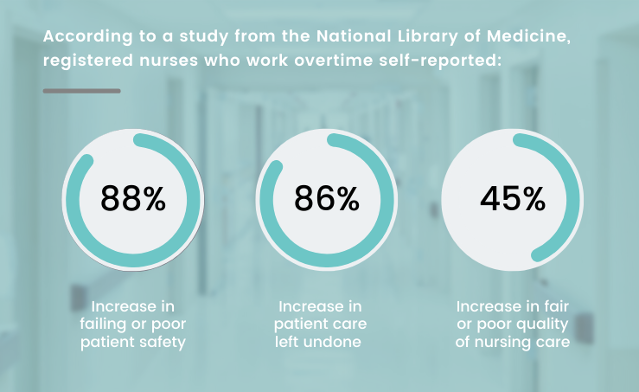What's causing the nurse shortage?
Increased Demand for Care
The demand for healthcare services has reached unprecedented levels, primarily driven by the intersection of an aging population and a surge in chronic diseases necessitating more intensive care. The challenges posed by this surge are particularly pronounced, considering the current demographic landscape of the United States, which boasts a historic high in the number of individuals aged 65 and above.
Aging Nurse Population
A significant portion of registered nurses and nurse faculty are also approaching retirement age. Fewer nurses working also means limited resources to train new ones. The scarcity of educational resources could cap enrollment numbers or decrease nursing education quality.
Decreased Interest in the Profession
According to AACN, nurses are leaving the profession than entering it at a rate of 15% per year. With less staff, nurses must work longer hours and take on more responsibilities – leading to increased stress and fatigue.
Data reveals that almost 900,000, or almost one-fifth of total registered nurses, intend to leave the workforce by 2027.
As a solution, hospitals have started offering incentives such as bonuses and increased pay for travel nurses to address these issues. However, this has been shown to be a bad deal for health systems and nurses.
How the Nurse staffing shortage puts patients at risk
Increased Nurse-to-Patient Ratio
Safe nurse-to-patient ratios are critical for both patient care and nurse retention. Despite the adverse risks, nurses across the nation must care for more patients than recommended because of the staffing shortage.
The quality of care provided to a patient decreases as the number of hospital patients assigned to a nurse increases. Each additional patient a nurse is given increases the likelihood of that patient dying within 30 days of admission by 7%. Additionally, patient satisfaction suffers when a facility lacks the appropriate staffing levels.
With more patients to care for, nurses are likely to miss their breaks, work overtime, and experience burnout. Nurses who feel burnout have more difficulty providing quality patient care and report work dissatisfaction.
A Nursing Outlook study showed that just one more patient per nurse was associated with a 23% increase in job dissatisfaction.
Less staffing can result in higher costs for hospitals in general. Decreased quality of patient care results in extended hospital stays and increased medical costs, negatively impacting the facility's perception.
Quality of Care
Several studies have indicated the correlation between inadequate staffing and decreased quality of patient care. With less staff support, nurses must spread their time across more patients, leading to:
- Less time to monitor patients: increased patient falls and accidents
- Rushed or incomplete nursing care: bathing, mouth care, feeding, and toileting
- Medication errors: delayed or missed doses of medication
Improper patient care can lead to increased length of stay, infection, patient dissatisfaction, readmission, and even more alarming – increased mortality rates.
Overworked Nurses
Nurses have reported feeling overworked since before the pandemic, and because the shortage has no end, many are considering leaving the profession. As nurses take on more patients, they take fewer breaks, miss meals, and strain to get through shifts. Fatigue associated with overworked nurses can put quality of care at risk:

Longer Wait Times
According to ECRI, Americans face longer wait times – even during life-threatening emergencies. Without the adequate staff to support a healthcare facility, emergency rooms become overcrowded – leading to increased hospitalization, procedures performed, permanent disability, or even death.
Fewer Hospital Visits
Patient dissatisfaction, longer wait times, and poor experiences compel individuals to delay or forego regular check-ups and treatments. Fewer visits can lead to more illnesses, further driving the need for healthcare services.
For some healthcare facilities, staffing levels have reached a critical point, pushing them to the brink of closure. This, in turn, forces patients to travel greater distances in search of medical attention.
Strikes: A Last Resort
Frustrated by unsustainable working conditions and their inability to provide the level of care they aspire to deliver, nurses across the globe are increasingly turning to strikes as a means of drawing attention to their plight. These strikes are not mere bargaining tools; they are desperate calls for change, resonating with the broader issues of workplace dissatisfaction, burnout, and the erosion of patient care standards.
Nurse strikes highlight the urgency of addressing the systemic issues contributing to the shortage. Nurses, in solidarity, demand better staffing ratios, improved working conditions, and fair compensation. As they take to the picket lines, their message is clear: the status quo is no longer tenable, and patient safety is hanging in the balance.
Hueman RPO's Travel Nurse Reduction Program
Hueman's Traveler Reduction Program significantly decreases premium labor costs for healthcare facilities, offering long-term savings and financial peace of mind.
We leverage over 28 years of experience in RN recruitment and dedicate recruiting resources to your traveler positions to help you escape from high premium labor spending. Using our seven-step program, our recruiting teams focuses their efforts solely on replacing travel nurses at your organization. We use advanced sourcing and networking skills to build a robust nurse pipeline for your existing and upcoming requisitions.
The Travel Nurse Reduction Program saves an average $3 million in the first year, with an average of $700k saved when an organization reduces ten travelers with staff nurses.
Ready to reduce your travel nurse costs? Visit out our dedicated solutions page or contact us today.





